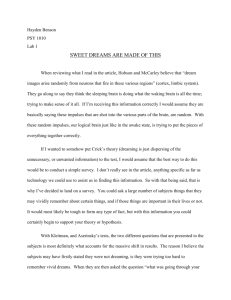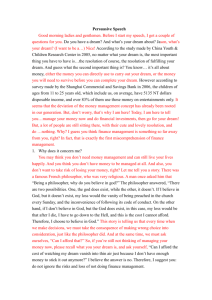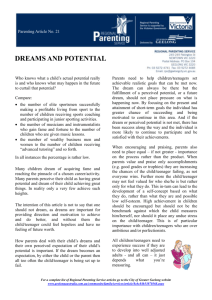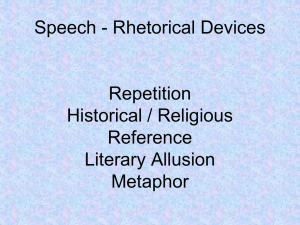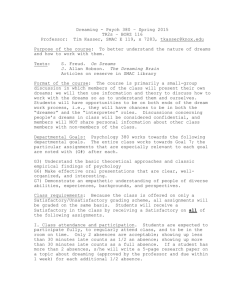Class Syllabus - Dreaming
advertisement
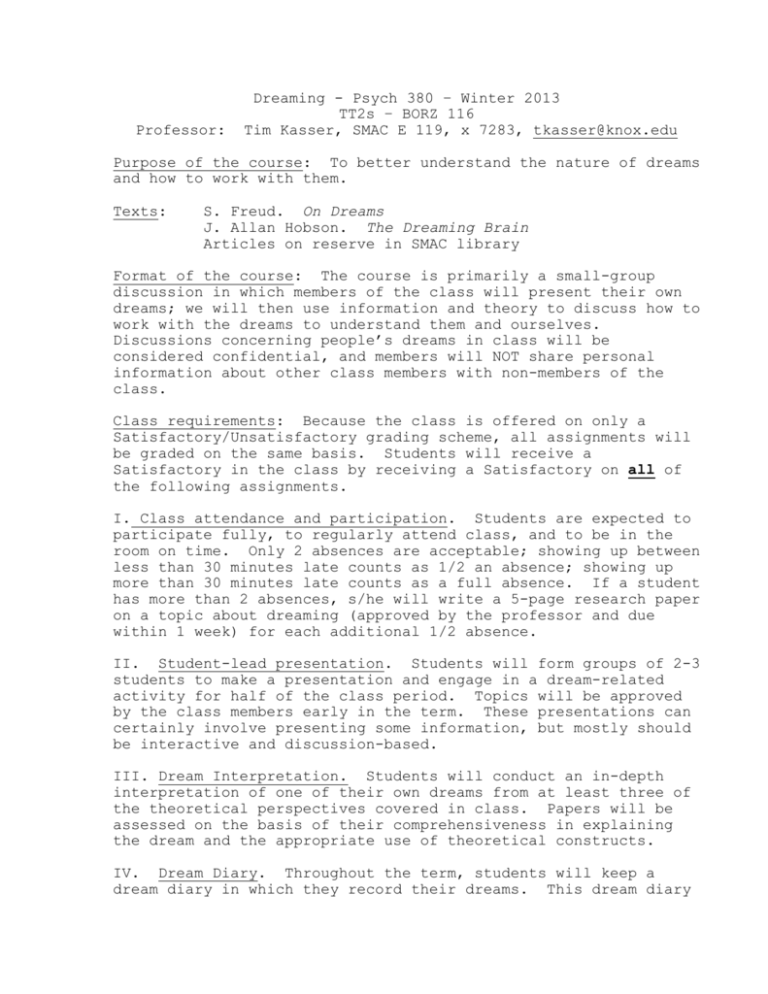
Professor: Dreaming - Psych 380 – Winter 2013 TT2s – BORZ 116 Tim Kasser, SMAC E 119, x 7283, tkasser@knox.edu Purpose of the course: To better understand the nature of dreams and how to work with them. Texts: S. Freud. On Dreams J. Allan Hobson. The Dreaming Brain Articles on reserve in SMAC library Format of the course: The course is primarily a small-group discussion in which members of the class will present their own dreams; we will then use information and theory to discuss how to work with the dreams to understand them and ourselves. Discussions concerning people’s dreams in class will be considered confidential, and members will NOT share personal information about other class members with non-members of the class. Class requirements: Because the class is offered on only a Satisfactory/Unsatisfactory grading scheme, all assignments will be graded on the same basis. Students will receive a Satisfactory in the class by receiving a Satisfactory on all of the following assignments. I. Class attendance and participation. Students are expected to participate fully, to regularly attend class, and to be in the room on time. Only 2 absences are acceptable; showing up between less than 30 minutes late counts as 1/2 an absence; showing up more than 30 minutes late counts as a full absence. If a student has more than 2 absences, s/he will write a 5-page research paper on a topic about dreaming (approved by the professor and due within 1 week) for each additional 1/2 absence. II. Student-lead presentation. Students will form groups of 2-3 students to make a presentation and engage in a dream-related activity for half of the class period. Topics will be approved by the class members early in the term. These presentations can certainly involve presenting some information, but mostly should be interactive and discussion-based. III. Dream Interpretation. Students will conduct an in-depth interpretation of one of their own dreams from at least three of the theoretical perspectives covered in class. Papers will be assessed on the basis of their comprehensiveness in explaining the dream and the appropriate use of theoretical constructs. IV. Dream Diary. Throughout the term, students will keep a dream diary in which they record their dreams. This dream diary will be turned in to the instructor every few weeks, and he will read a few of the dreams. If the student desires that a particular dream not be read, s/he is to write DO NOT READ at the beginning of the dream, or to cover it with paper. If the student desires ONE particular dream to be read, s/he is to include a note to the instructor directing him to the particular dream on which the student desires feedback. V. Regular Naps. Because naps during the day are times when people are especially likely to enter REM, I would like you to try to take at least two naps per week. Date 1/3 Schedule Reading None 1/8 1/10 1/15 Topic Syllabus What’s a dream? Psychoanalysis Psychoanalysis Jungian Approach 1/17 1/22 Paint our Dreams Dream Art Show 1/24 Biology of Dreams 1/29 Biology of Dreams 1/31 2/5 Presentations I & II Gestalt Dreamwork 2/7 2/12 2/14 Gestalt Dreamwork Dream Theatre NO CLASS – Prof. out of town Presentations III & IV Dream Incubation Dream Campout 2/19 2/21 2/25 (evening) 2/26 2/28 3/5 3/7 3/12 Finals Dream Incubation NO CLASS Senoi Senoi What’s a dream? N/A Freud Freud Jung & Whitmont None Edwards – Ch. 6 Hobson – Chs. 6, 9, & 15 Hobson Chs. 11-14 TBA Polster & Polster None Zinker TBA Reed None None None Garfield NONE NONE N/A Assignment Group A diaries Dream Art Group B diaries Presentations Group A diaries Presentations Group B diaries Final Paper



